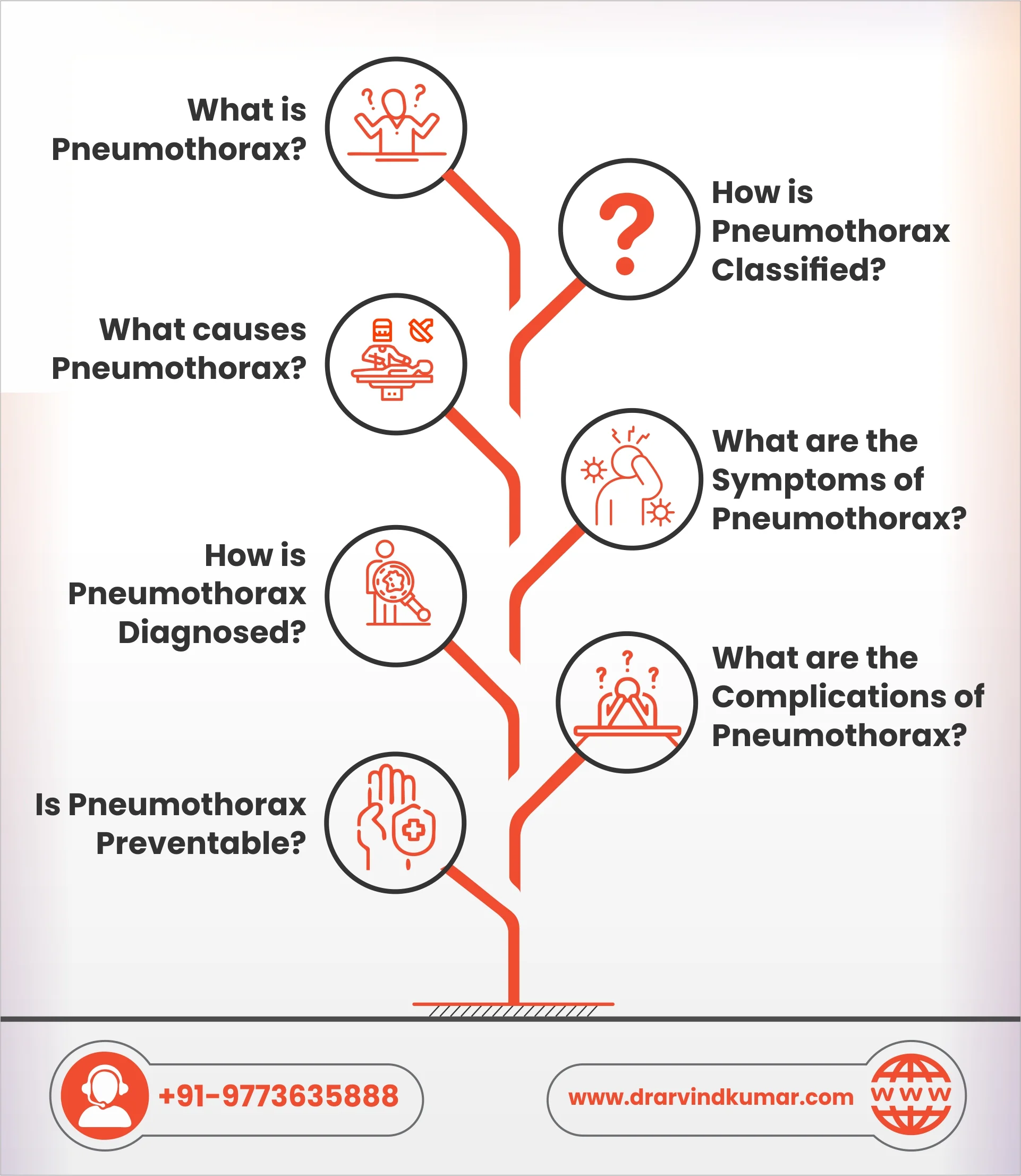A collapsed lung or pneumothorax is a matter of concern, especially in patients with pre-existing respiratory complications. In normal and healthy conditions, the lungs contract and expand as it is filled with air.
In pneumothorax, the air fills the area around the lungs, especially between the lungs and the chest wall, leading to increased pressure in the pleural space. This excess pressure pushes against the lungs, causing them to collapse.
If you are concerned with the symptoms you are experiencing, like chest pain and discomfort, it is ideal to seek immediate medical attention before this takes a turn for the worse. This article will explore pneumothorax signs and symptoms and how the condition is diagnosed.
What is Pneumothorax?
Pneumothorax is a medical condition that occurs when air enters the pleural space (the area between the lungs and chest wall). Since the area in the pleural space is limited and confined, excess air in the air causes a surge in pressure, which presses against the lungs, leading to the collapse. Depending on the air pressure, a pneumothorax can either be partial or total.
While partial lung collapse due to a small air leak is manageable with non-surgical techniques, total or severe lung collapse caused by multiple or larger air leaks inside the chest cavity requires immediate surgical interventions.
How is Pneumothorax Classified?
To better understand pneumothorax causes, we must pay close attention to the types of pneumothorax or collapsed lungs.
There are predominantly five types that are medically known. They include:
Primary spontaneous pneumothorax – Caused by abnormalities in the air sacs in the lungs, which break and release the air into the pleural space. It is common in young patients, especially very tall boys with no history of lung disease.
Secondary spontaneous pneumothorax – Common in patients with severe lung and respiratory disorders like chronic obstructive pulmonary disease (COPD), emphysema, cystic fibrosis, etc.
Injury-related pneumothorax – Blunt force trauma, accidents, and impacts on the chest due to accidents can lead to this type of pneumothorax.
Iatrogenic pneumothorax – This type of pneumothorax is caused by multiple medical procedures, including lung biopsy, insertion of central venous line, etc.
Catamenial pneumothorax – A very rare type of pneumothorax that happens with every menstrual cycle in women suffering from endometriosis where the endometrial lining grows on the diaphragm, leading to air getting sucked into chest from abdomen, coinciding with the menstrual cycle.
Understanding these types is key if you want to explore more about the condition, its complications, and its causes.
What causes Pneumothorax?
Now that you have a clear idea of what pneumothorax is and the different types let us explore the potential causes.
As we mentioned before, a lung collapse can be due to underlying complications, or it could be idiopathic, meaning there isn’t one particular cause behind the issue.
Following are some of the categories of causes and the potential reasons why:
| Type of Cause | Potential Reasons |
| Medical conditions | Asthma
Pneumonia Collagen vascular disease COPD Emphysema Cystic fibrosis Endometriosis Lung cancer Marfan syndrome Tuberculosis Acute respiratory distress syndrome, etc. |
| Injury or Trauma related conditions | Blunt force trauma to the chest
Ventilation issues Gunshot wound Lung puncture during a procedure Stab wound |
| Lifestyle conditions | Drug use
Scuba diving Deep sea diving Smoking Flying in high altitude |
| Genetic conditions | Family history of pneumothorax
Pregnancy Having thin yet tall body structure |
Since pneumothorax can be triggered by multiple causes, understanding each one of them is an absolute must.

What are the Symptoms of Pneumothorax?
The next question is, “What are the pneumothorax signs and symptoms?” How does one distinguish a potentially severe condition from a simple cough or cold?
A collapsed lung will lead to various symptoms that progressively worsen over time. So, if you are at risk of developing pneumothorax, pay attention to the following symptoms:
Chest pain that gets worse progressively while breathing
- Cough
- Faster heart rate or tachycardia
- Faster respiration rate
- Fatigue
- Shortness of breath
- Bluish tinge to the skin
- Confusion or dizziness
You might notice one of these pneumothorax symptoms or a collection of multiple symptoms. Whatever it is, if the symptoms don’t recover in some time, it could be a sign of collapsed lung, which requires immediate medical intervention.
How is Pneumothorax Diagnosed?
Pneumothorax diagnosis isn’t a very straightforward procedure. Since the symptoms often coincide with a lot of other complications, doctors might be confused right after the patient presents to them with the symptoms.
There are two routes of diagnosis:
Non-severe cases
In non-severe cases of pneumothorax where the patient has partial lung collapse; the doctor will start with the routine physical examination after listening to their symptoms.
This generally involves tapping the chest to check for abnormal sounds or recording the patients breathing rate via a stethoscope. The diagnosis also involves thoroughly understanding the patient’s medical history and lifestyle.
Depending on the symptoms, the next step in the diagnosis process is to order a few rounds of testing. The most important of them is imaging. Chest X-ray is the most effective way to diagnose the condition in a non-severe patient.
During the x-ray or other imaging tests, the technician will measure the size of the pneumothorax to determine the treatment.
Besides X-rays, CT-scan is also prescribed to the patient to get a comprehensive idea of the extent of the damage.
Severe cases
In severe cases of pneumothorax, where the patient is experiencing complete lung collapse, the symptoms are very prominent.
Such instances require immediate medical attention and hospitalization so the doctors can immediately start the treatment to revive the patient’s lungs before things turn fatal.
What are the Complications of Pneumothorax?
Collapsed lungs often pave the way for other complications in the body, including:
- Extra fluid secretion into the lungs
- Heart failure
- Infection in the lungs
- Difficulty breathing
- Death
Hence, paying close attention to the symptoms isn’t just a need but a necessity. If you are experiencing symptoms out of the blue that coincides with the signs of collapsed lungs, it is crucial that you prioritize getting medical attention before things take a turn for the worse.
Is Pneumothorax Preventable?
The prevention depends on the cause of pneumothorax. There are no ways to prevent the complication if the patient’s collapsed lung is due to a pre-existing medical condition or genetic predisposition.
However, if the pneumothorax is due to lifestyle choices, introducing healthy modifications to one’s lifestyle can help prevent the collapse from happening.
Conclusion
Pneumothorax is often an unexpected condition that can hit the patient out of the blue. If you have predisposed conditions or a family history of pneumothorax, prioritize regular screening with your doctor. Despite the condition not being fatal all the time, you shouldn’t take it lightly.
Dr. Arvind Kumar at Medanta offers comprehensive diagnosis and treatment for conditions like Pneumothorax. If you are experiencing symptoms that are causing discomfort or affecting your quality of life, schedule a consultation to get a better idea of what’s wrong.
For more details, visit:- https://drarvindkumar.com/.
FAQs
What is the first test for pneumothorax?
Pneumothorax is generally diagnosed via a Chest X-ray. In some cases where the doctor wants a more comprehensive understanding of the condition, a CT-Scan might be prescribed.
How long can a pneumothorax last?
The recovery from pneumothorax depends on the cause. If it is a partial lung collapse due to a small air leak, it takes around 1-2 weeks for complete recovery. On the other hand, if a larger air leak causes the condition, the recovery might take longer.

.webp)



